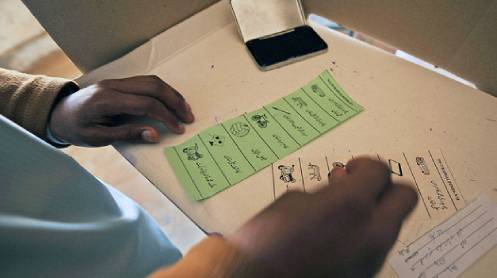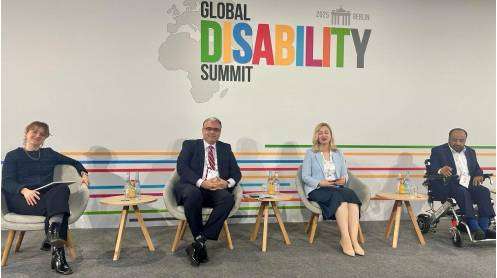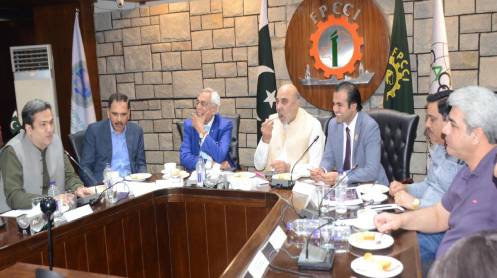Voters age 18-35 make up 45% of total electorate of nearly 130m
Streets are festooned with fluttering party flags, posters, banners and life-size portraits of candidates across Karachi in the run-up to the February 8 crucial national vote to elect a new government for a five-year term.
Through social media and election rallies, political parties are busy in last-ditch efforts to woo the voters. And this time, their main target is the young voters who make up 45% of the nearly 130 million strong electorate.
Aside from other election-related promises, almost all the contesting political parties are vying to coax the youth, promising to introduce new jobs, education and startups if they come into power.
The number of young voters, according to official data released by the Election Commission of Pakistan, has soared to 56.86 million from 46.43 million in 2018, positioning it to play a crucial role in the making of the new government.
Some 23.51 million voters are aged 18-25 years, while 33.34 million voters are aged 26-35.
Read more: Voter surge makes Pakistan fifth largest democracy in world
Savvy about social media tools, the cohort can not only influence the voters through online propaganda tools but also turn the table in many constituencies if they turn out in large numbers on polling day.
“Young voters undoubtedly make up a large chunk of the electorate, who can make a significant difference if (they) turn out in equally large numbers,” said Bilal Gilani, executive director of Gallup Pakistan, an Islamabad-based organisation involved in social, political and economic researches.
Speaking to Anadolu, Gilani observed that the political parties are “rightly” targeting this “untapped cohort” as most of them have not practically taken part in electoral activities despite being active on social media platforms.
“On the one hand, they are important and they are large in the voters’ list but in contrast, they have not been a significant part of the electoral activity in the last several polls,” he added.
Sharing a similar view, Kashif Hafeez, head of Karachi-based think-tank, Pulse Consultant, which monitors and conducts election surveys, said that a large chunk of young voters are “disengaged with the active politics if not disassociated.”
“The number of youngsters who are politically active on social media platforms is not more than 10% of their total strength. A brute majority of youngsters are involved in other social, cultural and entertainment-related activities,” Hafeez told Anadolu.
The politically active youngsters on social media, according to Hafeez, can make a trend but when it comes to practical participation, especially on the election day, “it’s not very encouraging.”
“Any political party that manages to activate the young voters can really make it,” he maintained.
Less likely to vote
According to the UN Development Programme, Pakistan currently holds one of the highest proportions of young people, as 64% of the total population of Pakistan is below the age of 30, while 29% is between the ages of 15 and 29 years.
Also read: PTI postpones intra-party elections
However, a faltering economy, unemployment and law and order situation have caused disappointment to a large number of youngsters, with many wanting to leave the country for better opportunities.
The track record suggests that despite being in higher numbers, and active on social media, the youngsters are less likely to vote in upcoming elections compared to voters above 40 years, according to Gilani.
“In 2018, the national voting turnout was 52%, whereas the turnout of voters aged between 18 and 30 years was 37%, marking a significant disparity between young and older voters (in terms of ballot cast),” he observed.
A 2021 survey by Gallup Pakistan suggested that some 37% of young people were not registered to vote or were unaware whether they were registered in the 2018 elections. Whereas, 27% were of the opinion that the elections would not make any difference.
Some 17% viewed that every candidate was the same. This time also, Gilani predicted, the young voters are less likely to go to polling stations compared to the older voters.
“In 2018 elections, there was a massive build-up by the PTI to attract young voters, but this time due to peculiar situation, the young voters are less likely to vote even compared to previous polls,” he further said, referring to Pakistan Tehreek-e-Insaf party of jailed ex-prime minister Imran Khan, which is facing a nationwide crackdown.
Its workers and leaders are accused of holding violent protests and attacking military installations following Khan’s brief arrest in a corruption case in Islamabad in May last year.
The party has already been stripped of its traditional electoral symbol “cricket bat” following a cumbersome legal battle, and its candidates are contesting as “independents.”
“We don’t have exact data for this but my assessment is that young voters’ turnout might be half the national voting turnout this year,” Gilani said.
The PTI is generally viewed as the party of young voters, a perception partially supported by Gilani and Hafeez.
“PTI is undoubtedly very popular with the young and first-time voters but other parties are also popular for this age group,” Gilani said.
In 2018, he added, close to 50% of youth voted for PTI but the other 50% voted for other parties. “My assessment would be that it will be similar for 2024 too.”
According to Hafeez, Khan enjoys more support from young and first-time voters compared to his arch-rival and three-time prime minister Nawaz Sharif, who is considered to be the prime choice of older voters.
Grappling with multiple civil and criminal cases, Khan, 71 is currently languishing in Adiala Jail in Rawalpindi. He was sentenced to 10 years in jail in a case that accused him of revealing state secrets and 14 years in a case related to the illegal sale of state gifts.
Cricket factor
Apart from his charisma and vigorous style, cricket is another factor behind Khan’s rise to Pakistan’s political landscape, otherwise dominated by the two traditional parties.
He led the national squad that clinched the only One-Day International Cricket World Cup in 1992 in Australia, a memory the nation still cherishes.
“Cricket runs in Pakistanis’ blood, and is the base of his (Khan) popularity among generations that he cashed in as a politician,” Qamar Ahmed, a former BBC cricket reporter and commentator, told Anadolu.
“He undoubtedly remains and will remain one of the most popular cricketers not only in Pakistan but in the world,” Ahmed, who covered nine out of 13 cricket world cups, added.







